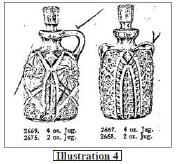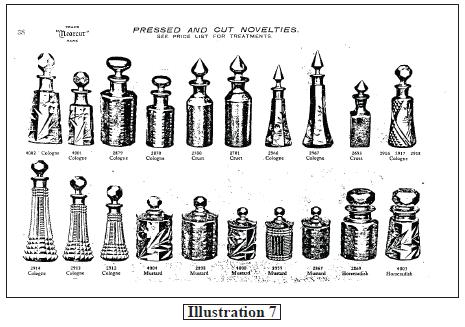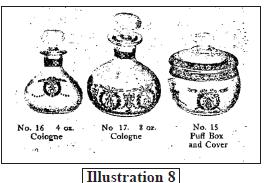Cambridge Perfume Bottles II
by Mark Nye
Issue No. 444 - January 2011
The first part of this two part series was written to be published
in an all color issue. Hence, rather than distract from the color
 by using reproduced portions of black and white
catalog pages, a number of perfumes were briefly
described and a reference made to the catalog
in which they appeared. For the most part these
perfumes are seldom seen today and when one
does appear, it can be difficult to identify it as
being of Cambridge origin.
by using reproduced portions of black and white
catalog pages, a number of perfumes were briefly
described and a reference made to the catalog
in which they appeared. For the most part these
perfumes are seldom seen today and when one
does appear, it can be difficult to identify it as
being of Cambridge origin.
The first perfume found in a Cambridge catalog was described as "3 oz. cologne, G. S." and appeared in a catalog issued circa 1916. The existing copy of this catalog was well used and during its use, "marked up." However, the cologne, located in the upper left corner of the page, escaped almost without markings as seen in Illustration 1.
The No. 2699 Buzz Saw Design appeared in the same circa 1916 catalog and with it, a 6 oz tall cologne bottle and stopper. (Illustration 2) Also shown in the 1916 catalog is the No. 2351 line and its Cologne Bottle and stopper. It was made in 2 sizes, 8 and 12 oz. (Illustration 3)
 Continuing on in the same circa 1916 catalog
one finds the page captioned "Glass Containers."
Many of the items illustrated on this page are
candy containers; however two could easily serve
as cologne bottles and each comes in two sizes.
These are the Nos. 2669 and 2675 single handled,
and 2667 and 2668 with double handles.
(Illustration 4)
Continuing on in the same circa 1916 catalog
one finds the page captioned "Glass Containers."
Many of the items illustrated on this page are
candy containers; however two could easily serve
as cologne bottles and each comes in two sizes.
These are the Nos. 2669 and 2675 single handled,
and 2667 and 2668 with double handles.
(Illustration 4)
T h e 2 8 0 0 Community Crystal Line, seen in Catalog No. 10, dating to circa 1920, contained a single perfume bottle, the No. 75 7 oz. cologne. (Illustration 5)
There are two pages in Catalog No. 10, one captioned "Oil Bottles" (Illustration 6) and the other "Pressed and Cut Novelties," (Illustration 7) having illustrations of cologne bottles. Other than the captions on the page of oil bottles, it is difficult to tell which is an oil bottle and which is a cologne.

This is not true on the other page, where the colognes share space with tooth picks, shakers, mustards and other dissimilar items. Only the top two rows of this page are reproduced here.
The deep plate etching Wedgewood is well illustrated in Catalog No. 10 and included among the items offered are two colognes, The No. 16, a 4 oz. cologne and No.17, in the same style but this one holding 8 oz. (Illustration 8)
In Part I, it was mentioned that damaged perfume bottles with metal atomizer caps attached had been found buried on the Cambridge factory site. The question was raised whether these were applied for a Cambridge wholesale customer, who would later apply the rest of the atomizer apparatus, or if this was an indication Cambridge sold perfume atomizers. Initial inspection of the caps led to the conclusion that they were not of DeVilbiss quality.
 Since then
additional experts in the field of Cambridge and related perfumes
have examined the pieces and concluded the fittings were indeed
not DeVilbiss fittings; rather they are typical of those seen on Vant
Woud bottles. It is known Cambridge produced bottles for Vant
Woud. As the result of finding the broken bottles, it can now be
concluded that Cambridge also applied the metal cap to at least
some of the bottles before shipment to Vant Woud.
Since then
additional experts in the field of Cambridge and related perfumes
have examined the pieces and concluded the fittings were indeed
not DeVilbiss fittings; rather they are typical of those seen on Vant
Woud bottles. It is known Cambridge produced bottles for Vant
Woud. As the result of finding the broken bottles, it can now be
concluded that Cambridge also applied the metal cap to at least
some of the bottles before shipment to Vant Woud.
At the time the bottles were found, most, if not all, had a broken foot. The initial speculation was the foot was broken during the application of the metal cap, the assumption being some type of pressure was used during the process. This is not true, no pressure is used. The metal cap is fastened to the glass collar using a small amount of plaster of paris, the same process used in making of oil lamps. How then did the feet get broken? Perhaps a worker dropped a tray of finished bottles in such a manner only the foot was broken. No doubt the answer will remain a mystery.


